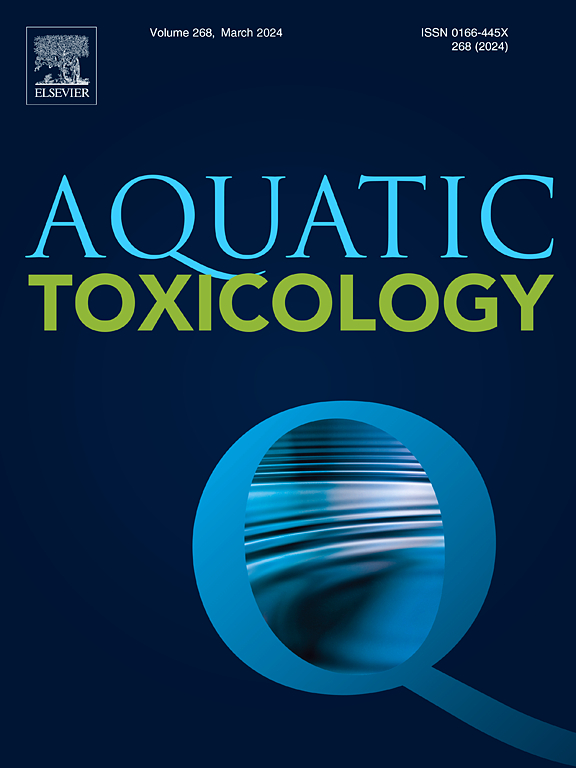Characteristics and potential human health risks of Paralytic Shellfish Toxins identified in eight species of bivalves from South Yellow Sea Mudflat
IF 4.3
2区 环境科学与生态学
Q1 MARINE & FRESHWATER BIOLOGY
引用次数: 0
Abstract
The consumption of bivalves contaminated with paralytic shellfish toxins (PSTs) poses a serious risk to human health. However, the presence of PSTs in bivalves from the South Yellow Sea Mudflat remains unclear. This study comprehensively examined the characteristics and potential health risks of PSTs in eight species of bivalves from the South Yellow Sea Mudflat across four seasons. Typical PSTs, including STX, dcNeoSTX, GTX1, GTX2, GTX3, and GTX4, were detected in white clams, clams, short-necked clams, blue mussels, razor clams, mussels, scallops, and oysters. Significant differences of PSTs concentrations among bivalves across different seasons were detected using Kruskal-Wallis tests (p < 0.05), with the highest PSTs concentrations found in mussels (20.46 μg/individual) during autumn. Furthermore, Pearson tests revealed significant positive correlations between PSTs concentrations and shell length, shell height, shell width, and soft tissue wet weight, indicating that larger bivalves contain higher PSTs levels. The highest dietary toxin intake (DTI) of PSTs across the four seasons was found in mussels (2.138 μgSTX eq. kg⁻¹ bw day⁻¹) during autumn. Notably, the exposure risk index (ERI) from bivalve consumption for male consumers was 1.23 ± 0.819, which was higher than that for female consumers (1.102 ± 0.735). The ERI of PSTs for children aged 2–7 and the elderly over 65 were 1.448 ± 0.957 and 1.316 ± 0.874, respectively, which were higher than those for other age groups, indicating that children and the elderly are more sensitive to PSTs. It is important to note that most ERIs of PSTs from total tissues were higher than 1 (potential risk), while ERIs of PSTs from non-digestive tissues were lower than 1, suggesting that potential health risks could be reduced by removing the digestive tissues of bivalves before consumption. This study provides valuable information for mitigating health risks associated with bivalve consumption.
在南黄海滩涂八种双壳贝类中发现的麻痹性贝类毒素的特征及其对人类健康的潜在风险
食用被麻痹性贝类毒素(PSTs)污染的双壳贝类会对人类健康造成严重危害。然而,南黄海泥滩双壳贝类中是否存在 PSTs 仍不清楚。这项研究全面考察了南黄海滩涂八种双壳贝类四季中 PSTs 的特征和潜在健康风险。在白蛤、文蛤、短颈蛤、蓝贻贝、蛏子、贻贝、扇贝和牡蛎中检测到了典型的 PSTs,包括 STX、dcNeoSTX、GTX1、GTX2、GTX3 和 GTX4。通过 Kruskal-Wallis 检验发现,不同季节双壳贝类的 PSTs 浓度存在显著差异(p < 0.05),其中秋季贻贝的 PSTs 浓度最高(20.46 μg/个)。此外,Pearson 检验表明,PSTs 浓度与贝壳长度、贝壳高度、贝壳宽度和软组织湿重之间存在显著的正相关关系,表明较大的双壳贝类含有较高的 PSTs 含量。在四个季节中,贻贝的 PSTs 膳食毒素摄入量(DTI)最高,为秋季(2.138 μgSTX eq. kg-¹ bw day-¹)。值得注意的是,男性消费者从双壳贝类摄入的风险指数为 1.23 ± 0.819,高于女性消费者(1.102 ± 0.735)。2 至 7 岁儿童和 65 岁以上长者的摄入量ERI 分别为 1.448 ± 0.957 和 1.316 ± 0.874,高于其他年龄组,表明儿童和长者对PST更为敏感。值得注意的是,总组织中 PST 的 ERI 值大多高于 1(潜在风险),而非消化组织中 PST 的 ERI 值则低于 1,这表明食用前去除双壳贝类的消化组织可降低潜在的健康风险。这项研究为降低与食用双壳贝类有关的健康风险提供了有价值的信息。
本文章由计算机程序翻译,如有差异,请以英文原文为准。
求助全文
约1分钟内获得全文
求助全文
来源期刊

Aquatic Toxicology
环境科学-毒理学
CiteScore
7.10
自引率
4.40%
发文量
250
审稿时长
56 days
期刊介绍:
Aquatic Toxicology publishes significant contributions that increase the understanding of the impact of harmful substances (including natural and synthetic chemicals) on aquatic organisms and ecosystems.
Aquatic Toxicology considers both laboratory and field studies with a focus on marine/ freshwater environments. We strive to attract high quality original scientific papers, critical reviews and expert opinion papers in the following areas: Effects of harmful substances on molecular, cellular, sub-organismal, organismal, population, community, and ecosystem level; Toxic Mechanisms; Genetic disturbances, transgenerational effects, behavioral and adaptive responses; Impacts of harmful substances on structure, function of and services provided by aquatic ecosystems; Mixture toxicity assessment; Statistical approaches to predict exposure to and hazards of contaminants
The journal also considers manuscripts in other areas, such as the development of innovative concepts, approaches, and methodologies, which promote the wider application of toxicological datasets to the protection of aquatic environments and inform ecological risk assessments and decision making by relevant authorities.
 求助内容:
求助内容: 应助结果提醒方式:
应助结果提醒方式:


